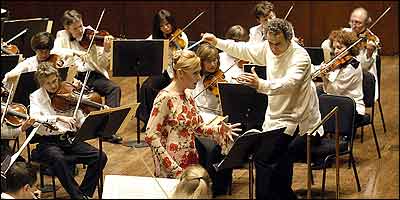
Only a couple of seasons ago, Mostly Mozart seemed doomed. The populist mandate (and inexpensive tickets) that made the festival such a success back in the sixties had long expired, the orchestra had begun to sound stodgy and demoralized, the programming was getting all too predictable, and audiences were finding other things to do in August. The whole thing could have been left to die a natural death, but big halls like Avery Fisher abhor a vacuum at any time of year, and a way had to be found to beef up good old Amadeus.
Luckily, its organizers have come up with a creative solution, and now “Mostly Mozart”—running though August 28—is exuding health and optimism. A glance at the festival’s final two weeks promises events that would have been unthinkable in the old days. Beginning on Monday, a four-part film series at the Walter Reade Theater will feature rare footage of great pianists, past and present, playing the music of Mozart and other composers: Emil Gilels, Evgeny Kissin, Martha Argerich, Rudolf Serkin, Maurizio Pollini, Arturo Benedetti Michelangeli, Solomon, and Glenn Gould, to name a few legendary ones. The Mark Morris Dance Group performs at the State Theater on August 19 and 21—and even if there’s no Mozart on the program, Morris fans are bound to be intrigued by what the choreographer will do with seven Monteverdi madrigals. Mozart does indeed meet modern dance on August 25, 27, and 28 at La Guardia Concert Hall, when Anne Teresa De Keersmaeker’s Ensemble Rosas performs dances based on a number of the composer’s choicest concert arias.
“Kozena’s voice seemed a trifle colorless for this deeply expressive music.”
“Mostly Mozart” goes out on its longest limb on the penultimate night of the festival, when music director Louis Langrée juxtaposes the composer’s Requiem with performances by Ghazal, an ensemble that plays Persian and Indian improvisations on the Indian sitar and tabla and Iranian kamancheh. Incorporating world music with Mozart’s quintessentially classical style may seem like a stretch, but fascination with the East was a very real phenomenon in the composer’s day, and musical influences from that part of the world often did creep into many composers’ scores in the late eighteenth century. Perhaps there are other parallels to be found as audiences look to make connections on their own. In any case, the evening is unlikely to be dull.
The central focus of “Mostly Mozart” continues to be the festival orchestra playing the music of its eponymous composer, and rightly so. The opening-night concert made that point explicitly with an all-Mozart program that included two of his most important works, the “Jupiter” Symphony and the Piano Concerto No. 24 in C minor, played by Yefim Bronfman, as well as an assortment of concert arias sung by mezzo-soprano Magdalena Kozena. Dozens of distinguished pianists have given memorable performances of the Mozart concertos at the festival over the years, and Bronfman’s elegantly turned, lyrically phrased interpretation joins the list. As for Kozena, she approached the arias with conscientious attention to musical detail, though her voice seemed a trifle colorless and stiffly managed for this deeply expressive music.
The real glory of the evening was Langrée’s bracing account of the “Jupiter” Symphony. The “Mostly Mozart” musicians use modern instruments, but a listener might well have mistaken the sound for that of a period orchestra, owing to Langrée’s preference for crisp articulation and a minimum of instrumental vibrato. The overall tempos were also unusually brisk, but the effect—especially in the finale, a miracle of five-part invertible counterpoint that would have dazzled even Bach—was never in danger of being garbled. Clearly this “Jupiter” was consciously conceived for modern tastes, and triumphantly played as such.